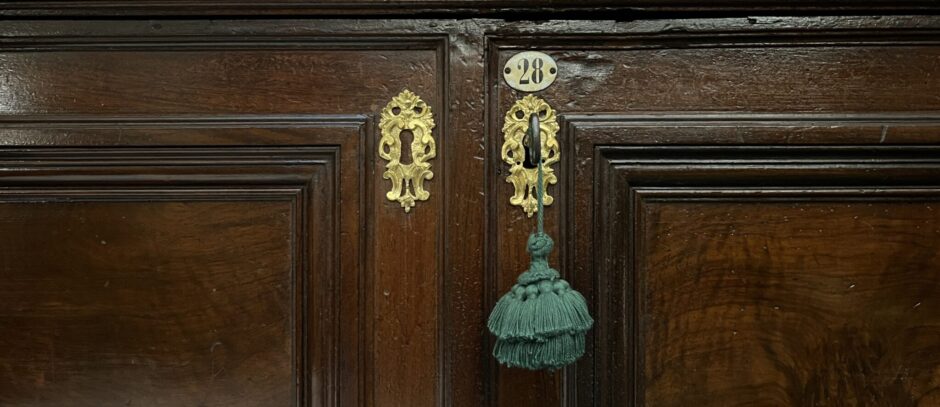 From CNA:
From CNA:
Vatican City, Mar 3, 2011 / 11:46 am (CNA/EWTN News).- Specially-trained guides are now available to offer one-of-a-kind tours of the Vatican Museums to the deaf and blind.
The museums’ staff announced the new service at a March 1 press conference. Initially, they will be offered for Italian speakers and signers.
In the tour for the blind and visually impaired, visitors are able to touch copies of two of “the 30 most important works” in the Pinacoteca – the Vatican museum that houses an extensive collection of paintings.
They are guided in groups of eight to examine a replica of Caravaggio’s “Deposition from the Cross.” The work depicts Christ being taken down from the cross to be laid in the tomb.
The experience of discovering the painting’s content and texture through the hands-on examination of a special three-dimensional bas relief replica is accompanied by Scripture and poetry readings that explain the moment, as well as sacred music inspired by the depicted event.
Tourists are also guided through second work in fresco from an artist named Melozzo da Forlì. It depicts an angel playing a stringed instrument. Both this piece and the copy of the “Deposition,” created in the same way as the original, are available to be touched.
The raised design works of art are also available to the visitor in a pamphlet that is available in both Braille and dark print.
In addition, for Caravaggio’s work, the guide enhances the tour by offering visitors the chance to smell aloe and myrrh, which were used 2,000 years ago to prepare bodies for burial.
According to a statement from the Vatican Museums, the experience will evoke the images represented in the paintings, “promoting the passage from simple knowledge to the more profound perception of the work in an integral appreciation.”
The director of the new program, Maria Serlupi Crescenzi, told Vatican Radio that the tour “is a sum of stimuli that permits entering in contact with the work, deepening both the cognitive and, of course, the emotional sphere.”
For the deaf, seven specialists in Italian sign language offer tours two days a week. L’Osservatore Romano called the new offering “without precedent or equal, at least in Italy.”
The new tours, offered only in Italian for now, are free for those visitors who reserve a place in the limited-sized groups.
WDTPRS Kudos to the Vatican Museum.


































At first, I thought your title was a joke. Black humor. How can the blind see a picture? But after reading your post, of course I realized how wonderful this is. The exhibit is enabling the blind to see. This is a great idea. Do you know if other museums do this?
Did you know that fewer than 10% of blind people can now read Braille? Studies have found that relying on technology alone instead of Braille leaves many blind people illiterate and less likely to go to college, find jobs, and live on their own. Overall 70% of blind adults are unemployed, but a study found 44% of adults who read Braille were unemployed, compared to 77% who could not read it.
um, hello? does anyone speak italian and want to be my translator so i can go to these exhibits? i’m only half-joking.
@digdiby: impressed at your knowledge of Braille and its pros and the cons associated with being functionally illiterate. I never would have gotten through college were it not for Braille, not to mention the fact that i never would have been able to start following a Misssal at the TLM or get nearly as much out of Fr. Z’s WDTPRS columns by comparing the latin to English cognates.
@faith: i don’t mean to pick on you, but the attitude you put forth in your post is a huge problem, for it is precisely that exhibited by the culture of death. when we view people myopically through the lenses of their limitations, it is easier for us to see them as less valuable or somehow ‘less” of a person than able-bodied individuals. of course blind people go to museums [can pictures not be described?] of course they go to movies, etc. visual beauty might not be the same to us as it is to you, but it is important and capable of being perceived nonethelesss. trust me, without a word of description from anyone, i am perfectly capable of telling when i walk into a recovated church vs. a beautiful one, a post-modern behemoth from a traditional masterpiece.
Very nice!
I used to have a very large poster, framed, of the Melozzo above, which I bought at the Vatican Museums. What a joy to spend a few days walking through the exhibits. God protect the fine arts and the Vatican for saving all of these interesting things.
The Caravaggio is also one of my favorites. I am so glad those who need help with “seeing” are getting a chance to do so. Beauty is an attribute of God. And, when men and women create art,they are partaking in the Nature of God Himself, His poesis, creatio ex nihilo, to our mimesis.
“@faith: i don’t mean to pick on you, but the attitude you put forth in your post is a huge problem, for it is precisely that exhibited by the culture of death.”
A bit over the top, isn’t it? Faith’s got a sense of humor, she laughed at a headline that looked like it might have been ripped out of the pages of “The Onion”, she became aware of another perspective after reading the post, and was broadened by it. What’s to scold her about?
A couple of evenings ago I saw on the CBS Evening News a report about a blind artist who, so improbably, is also a portrait artist. The likenesses of the subjects he paints are astonishingly accurate to the point where you’d swear he must be a fraud. I assume that he is authentically blind, however, which makes his talent almost miraculous.
centristian,
sorry, but no, i don’t believe i am speaking over the top here. i apologize if i made it seem as though i thought faith was being malicious, because that was certainly not my intent. my point, though, was that we as Catholics have an obligation to overcome our ignorance about what it is to have a disability in order to be consistent about our views.
millions of people with disabilities get institutionalized in nursing homes every year because people simply cannot conceptualize how their lives are worth living and how they could possibly function in the “normal” world. they are not given a chance to even try, they are simply housed away without consent and without an outcry from those living on the outside.
pregnant women get pressured to abort their babies diagnosed with disabilities because they are told that their lives will be too complicated, too burdensome, to live out, and they would be better off dead.
one of our outcries against abortion is that they target the poor, and they are based on stereotypes about the poor such as ‘once poor, always poor”, or “it would better to be aborted than eat raman noodles.” we also recognize that a lot of these false beliefs come from eugenicists like Margaret Sanger and the nazi regime. Well, if we can recognize that, then why is it over the top to say that our current views about how limiting it must be to live with a disability come from those same eugenicist views, the forced sterilizations which took place in America **before** germany, forced separation of disabled from nondisabled in the education system, etc? so, if we recognize that we have an obligation to educate people on the targeting of blacks by the abortionists, and that education must focus on fixing stereotypes, correcting language, and understanding what it really is like to be poor in America… then yes, i do believe we have this same obligation toward the disabled as well.
A lot of kids today are less likely to have ever known anyone with a serious disability, because there’s so much pre-emptive abortion going on. So I think there’s more theoretical sensitivity and friendly attitude, but a lot less experience applying it to real-life situations.
Lux Perpetua did say that she wasn’t mad at Faith. She was just mad that so many people don’t have this sort of application of experience or the imagination. Heck, I had no idea you could make tactile copies of paintings, and assumed they were talking about a sculpture tour exclusively.
It makes sense, since brushstroke patterns and masses of paint really are a big part of what we see. That’s part of why paintings look more impressive in person than in a perfect photograph that’s the same size and resolution. But most of us don’t think about that, even though art restorers obsess about that sort of thing.
I hope Lux Perpetua does get to Vatican City someday. It would also be nice if the tactile museum pamphlet were available for download.
I think this is a link to the Google Translate version of the Italian webpage about this, and here’s the Italian webpage itself, which includes Italian audio. There’s also a photo of how the tactile tour looks. It also ties into the current museum theme of art’s relationship to music, apparently.
On the subject of disabilities – a rant. Charity MUST go hand in hand with intelligence. A small minority of genuinely disabled people are in wheelchairs. Wheelchair activists have hijacked the Americans With Disabilities Act and have done astonishing damage. A plan to place Parisian style port-a-potties all over Manhattan (they even came up with a brilliant security system) was squashed because they were not ‘wheelchair accessible’. Never mind that they COULDN’T be made wheelchair accessible and be implemented. Never mind that twenty times as many New Yorkers have bladder control problems as are in wheelchairs. Not to mention those with all sorts of ‘walking wounded’, heart conditions, slipped discs etc etc for whom this would have been a Godsend. Since the Act, the fear of being sued means even the most tender-hearted employers will do anything NOT to hire the handicapped. Interesting what happens when the government ‘cares’.
digdigby:
you are sounding more and more like my kind of fellow. [or lady, but your writing somehow makes me guess you’re the former].
@supertradmum: you are 100% correct RE exposure. except that, before pre-emptive abortions, those with disabilities were often shipped off to homes, so lack of exposure has always been a problem.
lux_perpetua
wow! really? I’m your kind of fellow? Are you also a 58 year old male celibate bisexual Jewish convert to Traditional Catholicism?
um, no. :) except the conversion to trad Catholicism part.
i simply meant that we seem to have similar thoughts about these issues.
just said an Ave for you!